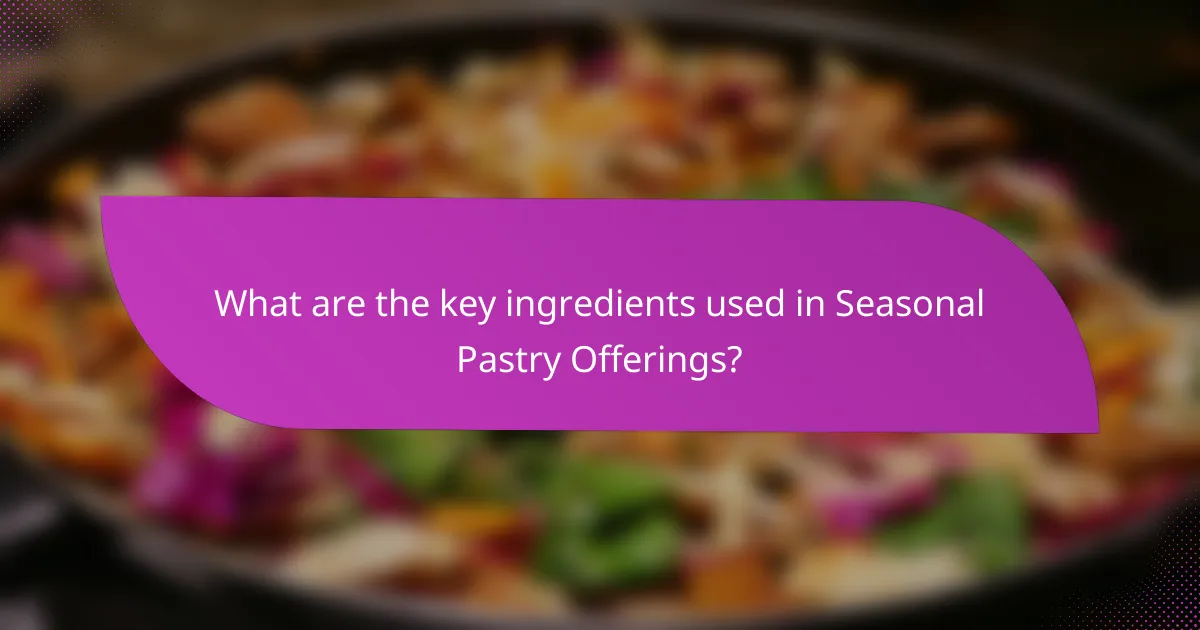Seasonal pastry offerings for New York events feature a variety of desserts that reflect local ingredient availability and seasonal flavor trends. Autumn highlights pumpkin spice éclairs, while spring introduces strawberry shortcake, with winter showcasing peppermint bark tarts and summer presenting berry galettes. Key ingredients such as flour, butter, sugar, and eggs are foundational, while seasonal flavors incorporate fruits and spices to enhance the pastries. Current trends emphasize bold spices, unique fruit combinations, and nostalgic flavors, driven by a consumer demand for creativity and authenticity. This article explores ingredient sourcing, flavor trends, and presentation ideas for seasonal pastries, providing insights into the evolving landscape of event catering.

What are Seasonal Pastry Offerings for NY Events?
Seasonal pastry offerings for NY events include pumpkin spice éclairs in autumn and strawberry shortcake in spring. These pastries reflect local ingredient availability and seasonal flavor trends. For example, pumpkin is abundant in fall, leading to its use in various desserts. Spring brings fresh strawberries, inspiring light and fruity pastries. Additionally, winter events often feature peppermint bark tarts, while summer showcases berry galettes. These seasonal selections cater to the preferences of event attendees. They enhance the overall experience by aligning with festive themes and seasonal celebrations.
How do Seasonal Pastry Offerings reflect local culture and traditions?
Seasonal pastry offerings reflect local culture and traditions by incorporating regional ingredients and flavors. These pastries often celebrate local harvests and seasonal festivities. For example, pumpkin pastries are popular in autumn, aligning with harvest festivals. Similarly, spring pastries may feature fresh fruits that are locally sourced. Seasonal offerings also draw on cultural heritage, showcasing traditional recipes passed down through generations. In New York, diverse communities influence pastry styles, merging various culinary traditions. This results in unique flavor combinations that resonate with local identities. The presentation of these pastries often reflects cultural aesthetics, enhancing their connection to local traditions.
What are the historical influences on NY pastry offerings?
New York pastry offerings are influenced by a diverse blend of cultural traditions. The city’s immigration history introduced various European baking styles, such as French, Italian, and Jewish pastries. For instance, the influx of Italian immigrants in the late 19th century popularized cannoli and tiramisu. Jewish communities contributed to the pastry scene with items like rugelach and babka.
Additionally, the culinary landscape of New York has been shaped by local ingredients and seasonal availability. The rise of artisanal baking in recent decades has emphasized quality and creativity in pastry making. Events such as the New York State Fair highlight regional flavors and seasonal specialties.
Overall, the historical influences on New York pastry offerings reflect a rich tapestry of cultural exchanges and local practices.
How do seasonal ingredients shape the offerings?
Seasonal ingredients significantly shape pastry offerings by influencing flavor profiles and presentation. Seasonal fruits like strawberries in summer and pumpkins in fall provide distinct tastes that define seasonal pastries. These ingredients ensure freshness and peak flavor, enhancing the overall quality of the offerings. Additionally, using seasonal ingredients supports local farmers and promotes sustainability. For example, a pastry featuring fresh apples in autumn reflects the harvest season, appealing to customer preferences. This approach not only creates variety but also aligns with consumer trends favoring local and seasonal products.
Why are Seasonal Pastry Offerings important for events?
Seasonal pastry offerings are important for events because they enhance the overall experience and align with seasonal themes. These pastries often utilize fresh, locally sourced ingredients that reflect the time of year. For example, autumn events may feature apple or pumpkin flavors, while spring events highlight berry or floral notes. Incorporating seasonal offerings can elevate the menu and create a more memorable occasion. Additionally, seasonal pastries can attract guests who appreciate unique and timely culinary experiences. Studies show that seasonal menus can increase customer satisfaction and engagement at events.
What role do pastries play in event catering?
Pastries play a significant role in event catering by enhancing the overall dining experience. They provide a variety of flavors and textures that appeal to guests. Pastries can serve as appetizers, desserts, or even main course elements, making them versatile. Their visual appeal adds to the presentation of the event, creating an inviting atmosphere. Additionally, pastries can be tailored to fit seasonal themes and dietary preferences, accommodating a wide range of guests. Their popularity is evident, as many events feature pastry stations or dessert tables. This trend highlights the importance of pastries in creating memorable culinary experiences at events.
How can seasonal pastries enhance the guest experience?
Seasonal pastries can enhance the guest experience by offering unique flavors that reflect the time of year. These pastries create a sense of nostalgia and comfort associated with seasonal ingredients. For instance, pumpkin spice in fall or fresh berries in summer evokes specific memories and emotions. Seasonal pastries also encourage guests to try new tastes that they may not typically choose. This variety can lead to increased satisfaction and enjoyment during events. Additionally, visually appealing seasonal pastries can enhance the overall aesthetic of the event. The presentation of these pastries can create a memorable visual impact that guests appreciate. Seasonal offerings can also cater to dietary preferences, such as gluten-free or vegan options, making them more inclusive. Ultimately, seasonal pastries contribute to a richer and more enjoyable guest experience at events.

What are the key ingredients used in Seasonal Pastry Offerings?
Key ingredients used in seasonal pastry offerings include flour, butter, sugar, and eggs. These ingredients form the foundation of most pastry recipes. Seasonal flavors often incorporate fruits like apples, pumpkins, and berries, depending on the time of year. Spices such as cinnamon, nutmeg, and ginger are also commonly used for seasonal pastries. Additionally, dairy products like cream and milk enhance texture and flavor. Nuts and chocolate may be included for added richness. Seasonal ingredients reflect local availability and trends, making pastries unique to specific events.
How do seasonal ingredients influence flavor profiles?
Seasonal ingredients significantly influence flavor profiles by introducing freshness and diversity. These ingredients reflect the natural growing cycles, which affects their taste and availability. For example, spring brings tender herbs and vibrant fruits, enhancing dishes with bright and zesty flavors. Summer ingredients like ripe tomatoes and sweet corn add sweetness and juiciness. Autumn yields root vegetables and spices, which impart warmth and earthiness. Winter ingredients often include hearty greens and citrus, contributing bitterness and tartness. Research shows that using seasonal produce can elevate the overall taste experience, as they are harvested at peak ripeness and flavor. This connection to seasons fosters a deeper appreciation for the ingredients and the dishes they create.
What are the most popular seasonal ingredients in NY?
The most popular seasonal ingredients in New York include apples, pumpkins, and asparagus. Apples are widely harvested in the fall, making them a staple in many dishes. Pumpkins are also prevalent during autumn, especially around Halloween and Thanksgiving. Asparagus is a spring vegetable that is highly sought after for its freshness. Other notable ingredients include strawberries in summer and kale in winter. These ingredients are often featured in local markets and restaurants, reflecting the seasonal availability. Their popularity is driven by local agriculture and culinary trends that emphasize fresh, seasonal produce.
How can unique ingredients elevate traditional recipes?
Unique ingredients can elevate traditional recipes by introducing new flavors and textures. They can enhance the overall sensory experience of a dish. For example, using saffron in a classic risotto adds a luxurious aroma and vibrant color. Incorporating exotic fruits like passionfruit can provide a refreshing acidity that contrasts beautifully with richer elements. Unique spices, such as sumac, can add a tangy depth that transforms familiar dishes. These ingredients can also create a visual appeal, making the dish more enticing. Additionally, they can cater to modern dietary preferences, such as gluten-free or vegan options, while maintaining traditional roots. The use of unique ingredients allows chefs to innovate while honoring culinary heritage.
What sourcing strategies are effective for seasonal ingredients?
Effective sourcing strategies for seasonal ingredients include establishing relationships with local farmers. Local sourcing ensures freshness and supports the community. Additionally, utilizing farmer’s markets allows access to a variety of seasonal produce. Seasonal ingredient lists should be created to align with harvest times. Collaboration with suppliers can also enhance sourcing efficiency. This approach minimizes transportation costs and reduces carbon footprint. Tracking seasonal trends helps in planning menus effectively. Engaging in community-supported agriculture (CSA) programs provides regular access to seasonal items.
How can local farms contribute to ingredient sourcing?
Local farms can significantly enhance ingredient sourcing by providing fresh, seasonal produce. They offer ingredients that are often harvested at peak ripeness. This results in better flavor and nutritional value. Local farms reduce transportation time and costs, leading to fresher products reaching consumers. Additionally, sourcing from local farms supports regional economies and promotes sustainability. Studies show that local sourcing can reduce carbon footprints associated with food transport. By collaborating with local farms, pastry chefs can create unique seasonal offerings that reflect local flavors. This approach fosters a connection between consumers and their food sources, enhancing the overall dining experience.
What are the benefits of using organic ingredients?
Using organic ingredients offers numerous benefits. Organic ingredients are grown without synthetic pesticides or fertilizers. This results in healthier food options for consumers. Organic farming practices promote biodiversity and soil health. Studies show organic produce often contains higher levels of antioxidants. For example, a study published in the British Journal of Nutrition found organic fruits and vegetables had up to 60% more antioxidants than conventional ones. Additionally, organic farming supports sustainable agricultural practices. This reduces environmental impact and promotes animal welfare. Overall, incorporating organic ingredients enhances both health and sustainability in food preparation.

What are the current flavor trends in Seasonal Pastry Offerings?
Current flavor trends in seasonal pastry offerings include the use of bold spices, unique fruit combinations, and nostalgic flavors. Bold spices like cardamom and ginger are gaining popularity for their warmth and complexity. Unique fruit combinations such as pear and rosemary or blood orange and thyme are being featured to create unexpected tastes. Nostalgic flavors like pumpkin spice and apple cinnamon remain staples, especially during fall events. Seasonal ingredients are prioritized, emphasizing freshness and local sourcing. According to a survey by the American Bakers Association, 65% of bakers reported an increase in demand for innovative flavor pairings in 2023. These trends reflect a growing consumer desire for creativity and authenticity in pastry offerings.
How do flavor trends evolve with the seasons?
Flavor trends evolve with the seasons by reflecting the availability of fresh ingredients and cultural influences. Seasonal produce dictates the flavors that are highlighted in culinary offerings. For example, spring often features bright, citrusy flavors like lemon and lime, while summer showcases berries and stone fruits. Autumn tends to emphasize warm spices and root vegetables, such as cinnamon and pumpkin. Winter flavors often include rich and comforting elements like chocolate and peppermint. These trends are influenced by consumer preferences, which shift with the changing weather and holidays. Research shows that 70% of consumers prefer seasonal flavors, indicating a strong market demand. This cyclical pattern allows chefs and bakers to create offerings that resonate with both seasonal themes and customer expectations.
What flavors are gaining popularity in the current season?
Autumn flavors are gaining popularity this season. Commonly favored flavors include pumpkin spice, apple cinnamon, and caramel. Pumpkin spice is often used in pastries and beverages. Apple cinnamon pairs well with both sweet and savory dishes. Caramel adds a rich sweetness that complements many desserts. These flavors reflect seasonal ingredients and consumer preferences. Seasonal trends show a rise in demand for warm, comforting flavors. According to food industry reports, these flavors are expected to dominate menus this fall.
How can pastry chefs innovate with flavor combinations?
Pastry chefs can innovate with flavor combinations by experimenting with unexpected pairings. They can blend sweet and savory elements, such as chocolate with chili or basil with strawberries. Incorporating global flavors can also lead to unique creations, like matcha in traditional desserts. Seasonal ingredients provide fresh options for innovation, enhancing flavors based on availability. Techniques such as infusing, layering, and textural contrasts can elevate the dining experience. For example, using smoked ingredients adds depth to classic pastries. This approach not only surprises the palate but also keeps offerings relevant to current trends.
What presentation ideas enhance Seasonal Pastry Offerings?
Creative plating enhances seasonal pastry offerings. Use seasonal colors to reflect the ingredients. Incorporate garnishes like edible flowers or fresh fruits. Serve pastries on rustic wooden boards for a homey feel. Utilize clear glass domes to showcase pastries attractively. Arrange pastries in varying heights for visual interest. Include themed decorations that match the event’s season. Use elegant serving ware to elevate the overall presentation.
How does visual appeal impact guest perception?
Visual appeal significantly impacts guest perception by influencing their emotional response and overall satisfaction. Aesthetically pleasing presentations create a positive first impression. This can lead to increased enjoyment of the food and a higher likelihood of return visits. Research shows that 93% of consumers base their purchasing decisions on visual appearance. When pastries are beautifully arranged and colorful, guests are more inclined to perceive them as high-quality. In events, this can enhance the overall atmosphere and elevate the perceived value of the offerings. Thus, visual appeal is crucial for engaging guests and enhancing their experience.
What are some creative ways to display pastries at events?
Creative ways to display pastries at events include using tiered stands, which elevate the pastries for better visibility. Another option is a dessert table with varying heights to create visual interest. Glass cloches can be used to cover individual pastries, adding elegance and intrigue. Edible flower garnishes enhance the aesthetic appeal of the display. Unique containers, such as vintage trays or wooden boards, can provide a rustic touch. Interactive displays, like a build-your-own pastry station, engage guests and encourage participation. Themed backdrops can complement the pastries, enhancing the overall event atmosphere. These methods not only attract attention but also enhance the overall experience for guests.
What best practices can be applied to Seasonal Pastry Offerings?
Best practices for seasonal pastry offerings include using fresh, local ingredients. This enhances flavor and supports local farmers. Incorporating seasonal flavors attracts customers seeking unique experiences. For instance, pumpkin in fall or berry blends in summer can create excitement. Presentation is crucial; visually appealing pastries increase customer interest. Utilizing themed packaging can also enhance the seasonal appeal. Regularly updating the menu keeps offerings fresh and engaging. Seasonal promotions or limited-time offers can drive sales and create urgency. These practices align with consumer preferences for quality and novelty in food experiences.
How can event planners effectively incorporate seasonal pastries?
Event planners can effectively incorporate seasonal pastries by aligning them with the event theme and season. They should select pastries that highlight seasonal ingredients, such as pumpkin in fall or berries in summer. Incorporating local bakeries can enhance freshness and support the community. Offering a variety of pastries caters to diverse guest preferences. Presentation is crucial; using seasonal decorations can elevate the display. Additionally, pairing pastries with seasonal beverages enhances the overall experience. Research shows that themed food offerings increase guest satisfaction and engagement at events.
What tips can chefs follow to create standout seasonal pastries?
Chefs can create standout seasonal pastries by focusing on fresh, local ingredients. Seasonal fruits and herbs enhance flavor and appeal. Utilizing unique flavor combinations can surprise and delight guests. Experimenting with textures adds depth to the pastry experience. Presentation plays a crucial role; visually appealing designs attract attention. Incorporating cultural elements can provide a unique twist. Staying updated with culinary trends ensures relevance. Lastly, tasting and adjusting recipes based on feedback can refine the final product.
Seasonal pastry offerings for New York events are characterized by their use of local, seasonal ingredients and reflect cultural traditions. The article explores various aspects such as ingredient sourcing, current flavor trends, and presentation ideas that enhance the guest experience. Key seasonal ingredients like apples, pumpkins, and berries are highlighted, along with the importance of innovative flavor combinations and visual appeal in pastry presentation. Additionally, the article discusses best practices for event planners and chefs to create memorable seasonal pastries that align with themes and elevate dining experiences.




